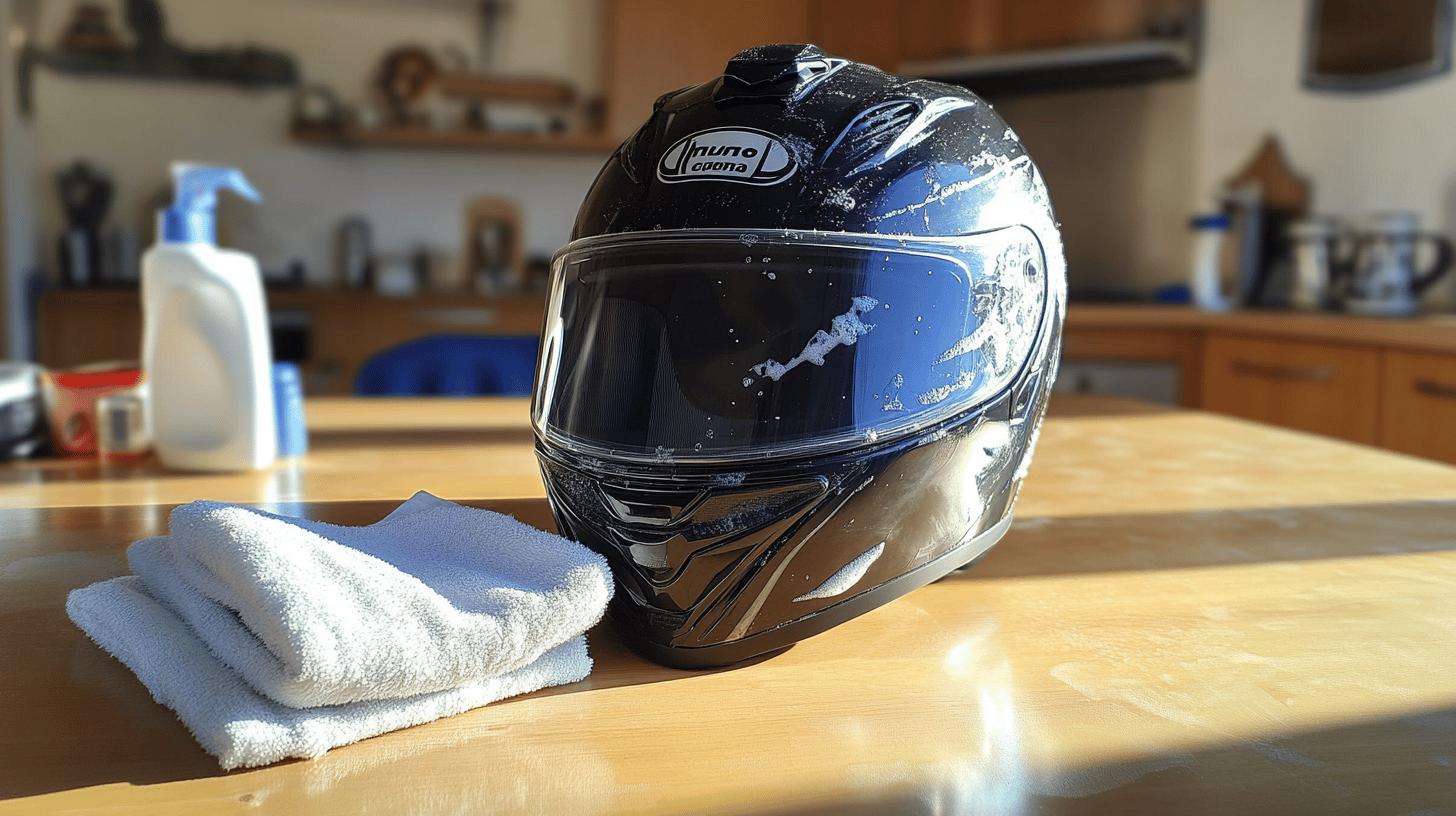Is your motorcycle helmet really past its prime, or does the 5-year rule have some leeway? This guideline has sparked conversations among motorcyclists about when to replace their most critical piece of safety gear.
Manufacturers and safety organizations endorse replacing helmets every five years to ensure optimal protection—truths you can't afford to overlook.
As helmets age, vital materials like glues and resins begin to deteriorate, threatening your safety on the road. Explore the reasoning behind this widely accepted rule and why ignoring it could jeopardize your safety.
Understanding the 5-Year Rule for Motorcycle Helmets

The 5-year rule for motorcycle helmets emphasizes the need to replace helmets every five years from the date of purchase. This guideline is widely recommended by manufacturers and safety organizations, including the Snell Foundation, due to the natural degradation of materials.
Over time, glues and resins used in helmet construction can deteriorate, affecting the helmet's structural integrity and protective capabilities. Replacing helmets at regular intervals ensures that riders maintain optimal safety standards.
Material degradation is a significant concern for helmet longevity. Glues and resins that hold the helmet's components together can break down over time, even if the helmet appears visually intact. Exposure to oil, sweat, and environmental factors accelerates this process.
The inner liners, responsible for absorbing impact, can also lose effectiveness. This degradation underscores the importance of replacing helmets every five years, regardless of their outward condition, to ensure the helmet's protective functions remain uncompromised.
Adhering to the 5-year rule is crucial for maintaining rider safety. Helmets play a vital role in protecting against head injuries during accidents, and their performance can diminish as materials age.
Following manufacturer recommendations and replacing helmets within the specified timeframe helps ensure that the safety standards are met. This proactive approach to helmet maintenance safeguards riders by guaranteeing that their gear remains reliable and effective.
-
Material degradation
-
Safety standard compliance
-
Manufacturer recommendations
- Impact on protection capabilities
Factors Influencing Motorcycle Helmet Lifespan

Motorcycle helmet lifespan is significantly influenced by the materials used in their construction. Helmets made from fiberglass, carbon fiber, Kevlar, ABS, and polycarbonate each offer unique benefits and challenges in terms of durability and performance.
Fiberglass and carbon fiber, for instance, are renowned for their high strength-to-weight ratio and impact resistance, contributing to a longer lifespan. However, these materials are not immune to degradation.
Over time, the resins that bind these fibers can break down, particularly if the helmet is frequently exposed to harsh conditions. Kevlar, while incredibly durable and impact-resistant, can also suffer from environmental wear.
ABS and polycarbonate helmets are typically more affordable, but their lifespan might be shorter due to less resistance to UV light and impact stress. This variability in material performance underscores the importance of selecting a helmet that matches the rider's specific needs and usage patterns.
External factors such as UV exposure and environmental conditions play a crucial role in helmet durability. Prolonged exposure to sunlight can cause significant damage to the helmet's outer shell, leading to fading and brittleness.
UV rays can penetrate the surface, weakening the structural components and reducing the helmet's ability to absorb impact effectively. Environmental conditions, such as extreme temperatures and moisture, also contribute to helmet degradation over time.
High temperatures can accelerate the breakdown of the helmet's internal foam lining, while moisture can lead to mold and mildew growth. These factors collectively contribute to the gradual wear and tear that helmets experience, even when not in active use.
Regular inspection and proper storage can mitigate some of these effects, but recognizing the impact of these external elements is vital for maintaining helmet longevity.
Environmental and Usage Influences
Environmental conditions and regular use significantly impact the lifespan of motorcycle helmets. Humidity and temperature fluctuations can cause materials to expand and contract, leading to micro-cracks and weakening of the helmet's structural integrity.
High humidity levels can particularly affect the helmet's interior, promoting the deterioration of padding and liner materials. Additionally, consistent use of a helmet exposes it to sweat and oils from the rider's skin, which can further compromise the interior components.
Sweat can seep into the helmet, leading to the breakdown of foam and adhesives over time. Regular cleaning and maintenance can help reduce these effects, but understanding how these environmental and usage influences affect helmet materials is key to ensuring continued protection and performance.
Safety Standards and Certification for Helmets

Safety certifications play a pivotal role in ensuring the quality and protective capabilities of motorcycle helmets. These certifications, like those from the Department of Transportation (DOT) and the Snell Foundation, are essential indicators that a helmet has undergone rigorous testing to meet industry safety standards.
For riders, choosing a helmet with these certifications means selecting gear that has been proven to provide effective protection during impacts, reducing the risk of head injuries. Certification processes often involve tests for impact resistance, penetration protection, and retention system strength, all designed to verify the helmet's ability to safeguard the wearer in the event of an accident.
Common standards like DOT and Snell are benchmarks for helmet safety that riders should prioritize when purchasing new gear. The DOT standard is a mandatory certification in the United States, ensuring that helmets meet minimum safety requirements.
The Snell certification, on the other hand, is a voluntary standard that often exceeds the DOT requirements, providing an extra layer of assurance in helmet performance. Helmets that carry these certifications not only comply with legal safety requirements but also offer enhanced protection features that could be crucial in severe riding conditions or accidents.
Understanding these standards helps riders make informed decisions when selecting helmets that best suit their safety needs.
| Certification | Purpose |
|---|---|
| DOT | Ensures basic safety compliance in the US |
| Snell | Exceeds basic standards for enhanced protection |
| ECE | European standard for safety and quality |
Identifying Signs for Helmet Replacement

Recognizing visible signs of damage is crucial for determining when a helmet needs replacing. Structural issues such as cracks in the shell or degradation of the Expanded Polystyrene (EPS) liner are immediate red flags.
These forms of damage compromise the helmet's ability to absorb impact, leaving the rider vulnerable during an accident. Inspecting the helmet regularly for such signs can provide an early indication that the helmet's integrity is compromised. Since these damages can sometimes be subtle, conducting thorough inspections is vital for rider safety.
Replacing helmets after accidents is non-negotiable, even if the damage is not immediately visible. An accident can significantly impair a helmet's impact-absorbing abilities, creating hidden weaknesses in its structure.
This invisible damage can be just as dangerous as visible cracks, as it reduces the protection level during subsequent impacts. For this reason, it is essential to replace a helmet immediately following any collision to maintain optimal safety standards.
Excessive wear affects both the fit and protective levels of a helmet. Over time, padding within the helmet can become worn out or loose, leading to an improper fit that fails to secure the rider's head adequately.
A poorly fitting helmet can shift during a crash, diminishing its effectiveness. Regularly checking the fit and condition of the helmet is important to ensure it continues to provide the necessary protection.
-
Cracks or visible damage
-
Loose or worn-out padding
-
Compromised chin strap
-
Helmet involved in an accident
-
Excessive wear causing fit issues
Best Practices for Helmet Care and Maintenance

Regular maintenance is crucial for extending the lifespan of motorcycle helmets. Consistent inspection and cleaning routines not only preserve the helmet's condition but also ensure that it continues to provide the necessary protection.
Riders should routinely check for visible damage such as cracks or wear, as these can compromise the helmet’s ability to safeguard the head during impacts. By addressing these issues early, riders can prevent minor damage from escalating into significant safety risks.
Additionally, maintaining a clean helmet helps in identifying any structural issues that might otherwise go unnoticed due to dirt or grime accumulation.
Improper cleaning products and storage conditions can significantly impact helmet materials. Using cleaners with petroleum-based products can degrade the helmet's structural components, including the shell and inner lining.
Such degradation reduces the helmet’s protective capabilities over time. Instead, mild soap and water should be used to clean the helmet, ensuring that both the exterior and interior components remain intact and effective.
Proper storage is equally important; helmets should be kept in cool, dry places away from direct sunlight to prevent UV damage and moisture buildup, both of which can accelerate material deterioration. By adhering to these maintenance practices, riders can maximize their helmet's durability and performance.
-
Inspect for visible damage regularly
-
Use mild soap and water for cleaning
-
Avoid petroleum-based cleaners
-
Store in a cool, dry place away from sunlight
-
Check fit and wear regularly to ensure safety
Choosing the Right Replacement Helmet

When buying a new helmet, the first consideration should be safety certifications such as DOT or Snell. These certifications guarantee that a helmet has passed rigorous tests to meet or exceed industry safety standards.
A helmet with these certifications offers assurance of impact resistance and durability, which is critical in protecting riders during accidents. Certification ensures that the helmet has the structural integrity required to absorb and disperse impact forces effectively, reducing the risk of head injuries.
Fit and comfort are equally crucial when choosing the right helmet. A snug fit is essential to prevent the helmet from shifting during a ride, which can compromise its protective capabilities. Comfort features such as padding and liner materials should conform to the rider's head, offering both security and ease of wear.
A helmet that fits well encourages regular use, which is vital for maintaining safety on the road. Without a proper fit, even a certified helmet cannot provide the optimal protection it is designed to deliver.
Additional features such as ventilation systems, lightweight materials, and adjustable fit systems can enhance both safety and user experience. Ventilation helps regulate temperature and moisture, improving comfort during long rides.
Lightweight materials like fiberglass or carbon fiber contribute to reduced neck strain while maintaining protective strength. Adjustable fit systems allow for customization, ensuring that the helmet remains secure and comfortable as padding settles over time.
-
Safety certification (DOT, Snell)
-
Material composition (fiberglass, carbon fiber)
-
Ventilation and comfort features
- Adjustable fit systems
Final Words
Adhering to the 5-year rule for motorcycle helmets ensures a balance between material degradation and adequate protection. Helmets shield riders from harm, yet materials like glues and resins degrade, impacting safety.
Recognizing factors influencing helmet lifespan, understanding safety standards, and knowing when to replace your helmet are crucial steps toward optimal protection.
By maintaining and choosing the right helmet, riders enhance their safety. Following helmet replacement guidelines fosters a safer riding experience.
FAQ
What is the 5-year rule for motorcycle helmets?
The 5-year rule signifies the recommended replacement of motorcycle helmets every five years from the purchase date due to material degradation like glues and resins, as recommended by manufacturers and safety organizations.
How long do motorcycle helmets last if not used?
Motorcycle helmets can still degrade over time due to environmental factors like UV exposure and materials aging, even if not used, making regular assessment necessary for safety.
How can I tell if a motorcycle helmet is still good?
To determine if a motorcycle helmet is still good, inspect for visible damage such as cracks, loose padding, or strap wear, which can compromise protection.
Can I use a 10-year old motorcycle helmet?
Using a 10-year-old motorcycle helmet is not recommended since materials could have expired, reducing its protective effectiveness and potentially failing safety standards.
Should you replace a motorcycle helmet if you drop it?
Yes, replace a motorcycle helmet if dropped, as the impact can compromise the structural integrity and safety capabilities of the helmet.
What should I do with an old motorcycle helmet?
An old motorcycle helmet can be repurposed for non-riding activities, used as a display item, or recycled according to local waste guidelines if no longer suitable for safety use.
Do helmets expire after 5 years?
Helmets are generally recommended for replacement after 5 years due to potential material degradation, ensuring they continue to meet safety standards and protective capabilities.
Do I really need to replace a motorcycle helmet every 5 years?
Replacing a helmet every 5 years is advised due to material degradation and to maintain compliance with evolving safety standards and manufacturer recommendations.
How do environmental conditions affect motorcycle helmet lifespan?
Environmental conditions like humidity, temperature, and UV exposure contribute to material degradation, reducing a helmet’s lifespan even without frequent use.

Ryan Thompson is a 35-year-old sport bike enthusiast known for his adventurous spirit. With years of weekend rides and exploring new roads, Ryan brings fresh insights and firsthand experience to ProtectiveGearz. His energetic approach and passion for the latest gear make him a trusted source for riders seeking up-to-date advice.



